“It’s like a Saturn V rocket, except it’s upside down.” Howard Fields is excited, and with good reason: things at Anomera are poised to takeoff, and in a big way.
Anomera, for the uninitiated, is a small company based in Montreal with locations in Mississauga, Ontario and Témiscaming, Quebec. Anomera specializes in nanoparticles, specifically, carboxylated nanocrystalline cellulose, or CNCs for short. And while the company may be small, and the particles they sell much, much smaller, they are on the verge of big things. Very big things.
The rocket he is describing is actually a 29,100-gallon stainless steel, 5½ story tall spray dryer, and yes, it does look like the famous moon-launch rocket of the 1960s and 70s. Installing it at their plant in Témiscaming, Quebec required a 200-foot tall crane to lift and lower the unit into their 10 story high Special Materials Factory (SMF), as well as a second crane to assist in lifting the spray dryer from the horizontal truck bed safely to a vertical position. Fitting the spray dryer will bring the capacity of the SMF up to 250 tons a year when the SMF goes onstream later in July. It was a lot of careful work to place the whale-sized behemoth with microscopic precision.
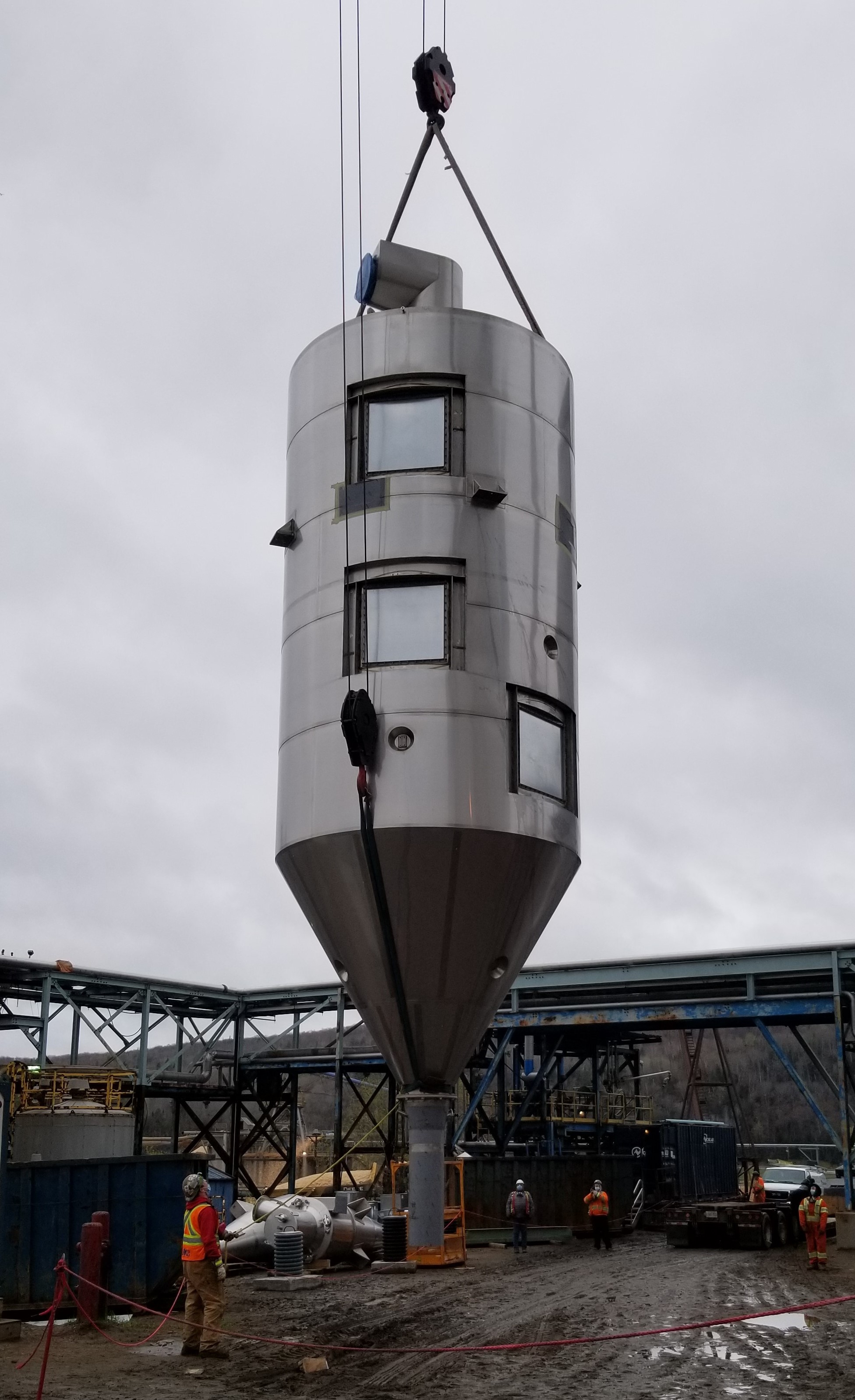
“A plant like this has never been built before,” says Fields. “Our production method of carboxylated CNC is absolutely unique, and the plant operates with no manual switches; we can run the entire facility from a tablet.”
In other words, it was just another day at Anomera, where Fields is President and CEO since 2018.
The story of how the company got to this stage begins much earlier, and is so full of twists and turns, serendipity and coincidences, it is hard to believe it is not a Hollywood film. Indeed, there is a sense that the hand of fate was casually involved in the process, putting people in the right place at the right time, as though on cue.
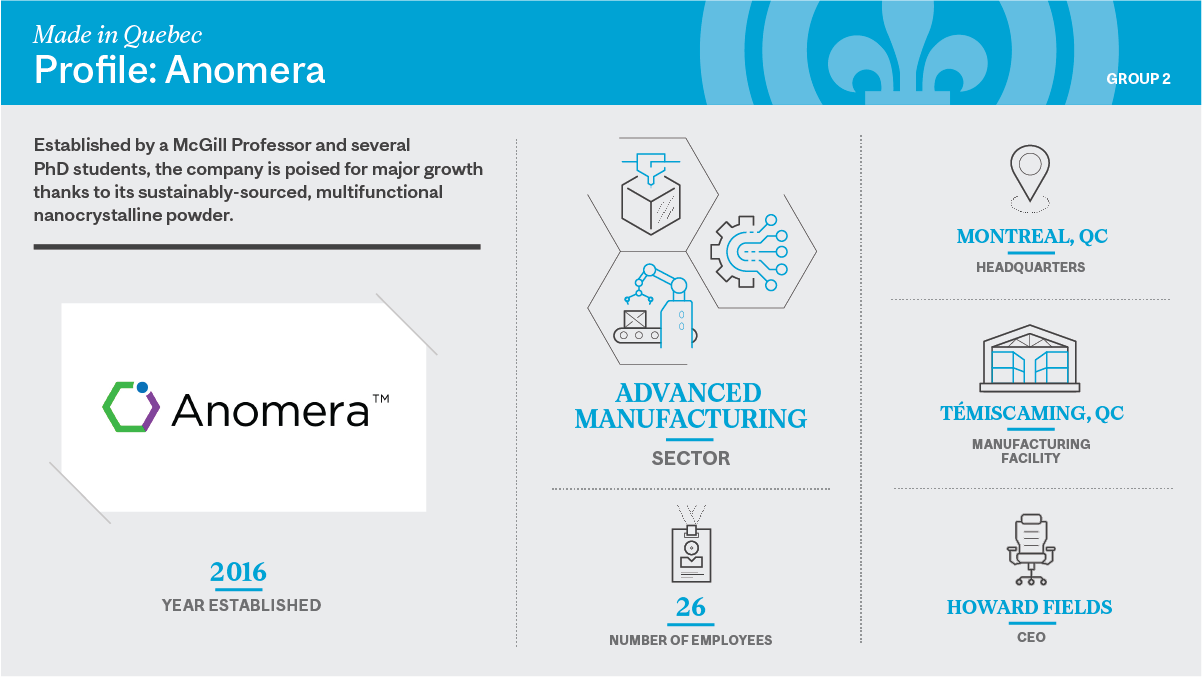
From encryption to pigmentation
It all started in a chemistry laboratory at McGill University way back in 2009. Professor Mark Andrews was helping an Engineering student who was exploring cellulose nanocrystals. Perhaps by using their natural ability to polarize light, the nanocrystals might be used as a printable component in optical encryption for anti-counterfeit tags.
But instead of just finding a tool to lock things away from counterfeiters, Andrews wanted to unlock the long-known potential of cellulose nanocrystals to yield natural color, like the shimmering iridescence similar to the natural colors occurring in butterfly wings or the eye of peacock feathers. By imitating nature to make minute regular patterns of nanocrystals, they were able to pivot through the visible spectrum, so that any vibrant iridescent colors could be replicated.
It was a serendipitous moment for Andrews. But there were more to come.
Shortly after this, a French exchange student who had taken part in the McGill research returned to present her thesis at the Ecole Supérieure de Chimie Organique et Minérale. Her talk on the colorization properties of nanocrystals attracted the interest of an audience member, who, by serendipity, happened to be a research scientist of one of the world’s most famous and valuable cosmetics companies: Chanel.
The scientist, Philippe Guarilloff, eventually met Professor Andrews, and the two signed a research agreement. Chanel was interested in the colorful properties Andrews had advanced. The challenge was how to scale them up in a commercially feasible manner. In fact, it was on this point – supply – that the project took a whole new direction.
Andrews had been sourcing his cellulose nanocrystals from a commercial supplier, who were reluctant to part with their difficult-to-fabricate product. Andrews eventually decided it would be simpler to fabricate their own stock of the tiny particles.
Cellulose, as many people probably know, is the main substance in the walls of plant cells, and for industrial purposes it is most often obtained from trees. Indeed, trees yield a wide variety of compounds that are offshoots of the pulp and paper production process, which includes nanocrystals. But the common way of obtaining these crystals is through a process using sulphuric acid, which is a not particularly environmentally friendly substance. Andrews wanted to find another way.
It was with the imagination of at-the-time graduate student Tim Morse that they found a method to synthesize nanoparticles using dilute hydrogen peroxide. The technique also provided a crucial bonus: not only did the process yield only water and low concentrations of mainly sugars as waste, but the peroxide decorated the nanocrystals with a much sought after carboxylic acid moiety (moiety is a part of a molecule). And, the crystals were free of sulfate, an important criterion for many cosmetic products.
“Tim is able to look at old science in a new way,” explained Andrews on their collaboration. Their process eventually lead to breathtaking colors when the nanocrystals were combined with cosmetically approved dyes. It also helped that Professor Andrews is more than a chemist – he is also an award-winning visual artist. “The colored nanocrystals became my palette,” he said.
So, having found a new method to synthesize nanocrystals to make vibrant colors for their corporate research partner, one could assume that the story would end there. Except, as fate would have it (and in keeping with the twists-and-turns theme), things changed considerably following a visit by Chanel to Andrews’s lab.
The gel that changed history
In this instance, the Chanel delegation was headed by Christian Mahé, Vice President of research at Chanel. The visit was to see how things were progressing in the project. But upon a look around the lab, Mahé became curious about a white gel sitting in a flask on a bench top.
“What’s this?” he asked. “That’s the nanocrystal powder in gel form,” Andrews replied. Mahé smoothed the gel between his fingers. It was yet another ‘aha’ moment. It had a silkiness unlike anything he had felt. And in this form, the nanocrystals could be used to create not only rich sustainably sourced pigments but – and this is the best part - a new industry standard to replace plastic microbeads with a biodegradable alternative.
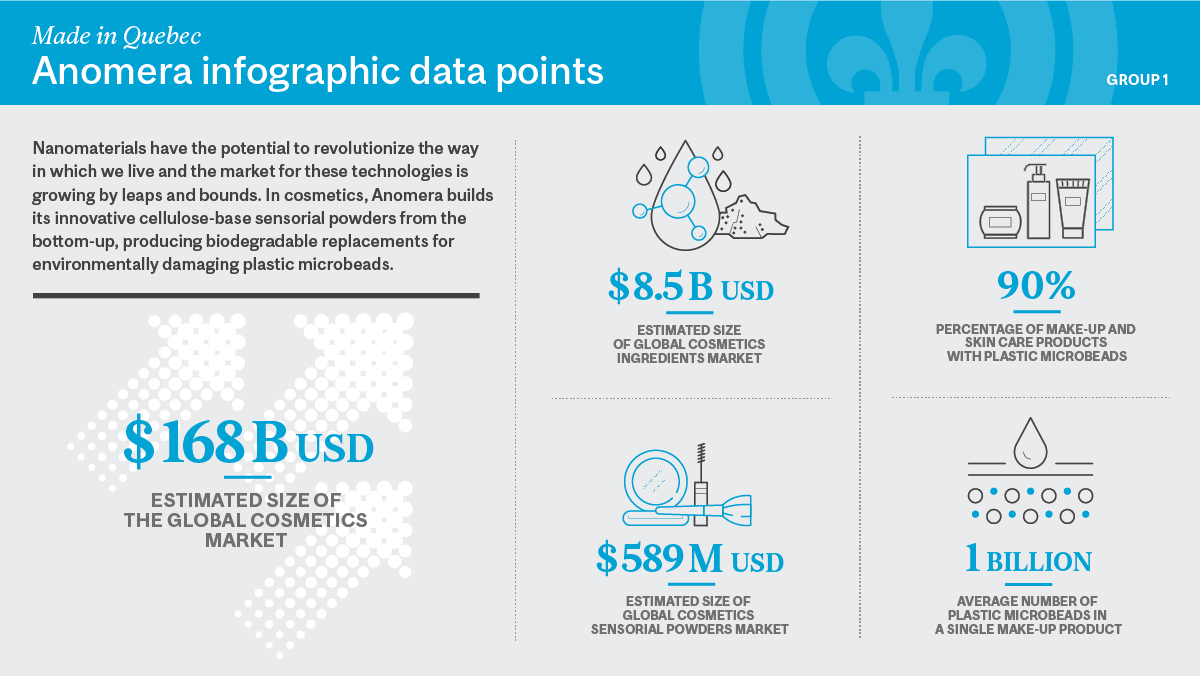
Plastic microbeads are a significant pollutant in the natural environment, and a major headache for the cosmetics industry. Although patented for personal care products in the plastics boom of the 1960s (remember The Graduate?), microbeads became the go-to material for the industry in the 1990s, and used in all types of skincare items, such as lotions, body washes, toothpastes, shampoos, sunscreens, shaving creams and exfoliators. But they also became a major pollutant, and one that unfortunately bypasses most municipal water filtration systems. Today researchers estimate that Lake Ontario contains 1.1 million particles per square km, and removal is near impossible.
Although many countries, including Canada, have banned microbeads, there are still many nations that continue to use them, while other countries are in transition. And many bans are only concerned with rinse-off microplastics, while the leave-on variety are still OK for consumption. But even these products eventually find their way into the environment.
After the accidental discovery of the gel, Chanel changed the research program with the McGill team. No longer was the focus on iridescent colors, but natural pigments for cosmetically approved products. And the environmental qualities of their production method suddenly took on new importance. Finding solutions to these issues meant connecting a few new dots for Andrews.
“There is no way you could contract a company to do this,” he said. “It’s an art form.”
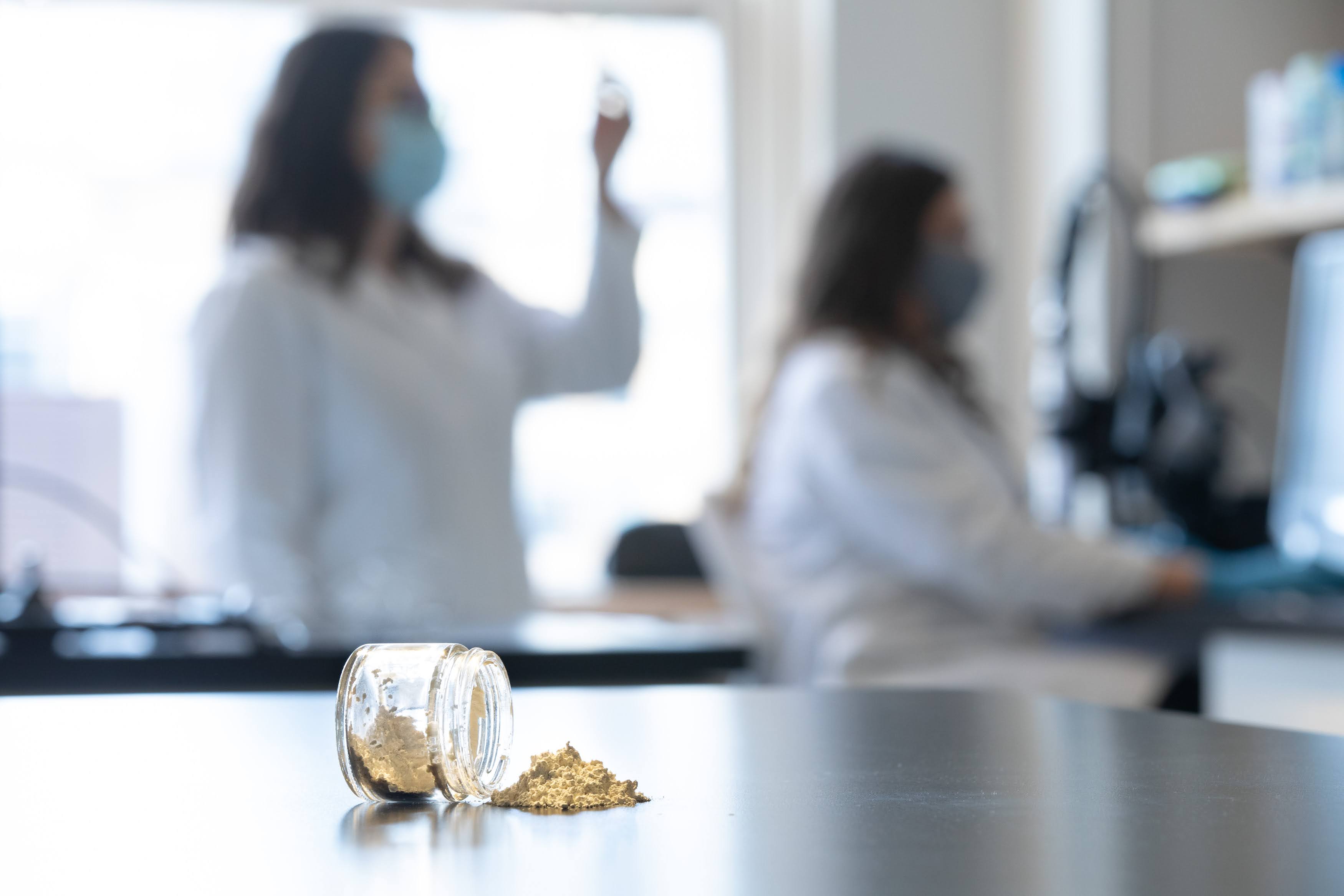
One problem was producing the nanocrystals in powder form without using freeze drying. Andrews grew up in a big family – seven boys who drank a lot of powdered milk for protein and carbohydrates. Knowing that powdered milk was made by spray drying, Andrews told Morse to spray dry the water suspensions of colored nanocrystals. It worked beautifully. But how to show that their discovery could be scaled up to manufacturing levels? They cold-called Xerox Canada who had developed dry toner inks about the same size as their cellulose microbeads. Could the Xerox process be adapted to his needs? Although it was a new application for the technology, the short answer was yes.
Realizing commercialization
By this time, it was abundantly clear a commercial avenue was opening. Andrews had already assembled a team of McGill-trained specialists – in addition to Morse there was Monika Rak (PhD, Chemistry), Nathan Hordy (PhD, Chemical Engineering), and Mary Bateman (Master’s. Chemistry). Together they incorporated the company.
Rak’s introduction to the project began as she was finishing her doctorate and working on a project involving oxidation reactions under supervisor Professor Audrey Moores. But when she took the results to Professor Andrews, he spontaneously asked her: “Do you want a job?” Although she does not claim to be the most entrepreneurially minded person, she leapt at the opportunity.
Initially, the lack of security inherent in running a start-up was “terrifying,” but Anomera’s environmental mission was a crucial factor for Rak’s decision to stay. “My intention was to work in a company looking to ameliorate the problems caused by our consumer lifestyle,” she explained.
Conversely, Hordy had previous exposure to startup life. He had been involved with a company that was developing a new PCR testing device (back in 2014, it was not the household term it is today), but the technology they were developing was not ready for prime time. He was referred to Andrews by Innovation and Partnerships Director Mark Weber, who knew that Hordy’s training as an engineer would be a good fit for the young team.
Indeed, Anomera’s initial relationship with Chanel was a strong draw for Hordy. “If you have that industry pull, it gives you a lot better chance at succeeding,” he said. And while his initial taste of entrepreneurship may not have resulted in an ideal outcome, it left Hordy hooked: “I caught the bug and realized that this is what I want to do with my life.”
Andrews himself was no newcomer to the startup world. Having previously launched two companies, and holding patents in other technologies, he knew the ins and outs of launching a business, finding investors, and building a client base. He made sure to include his team in these decisions as well.
Finding a name for their company was also a group activity, and it was during one of their multiple driving trips that they came upon the name Anomera, derived from the chemical term anomer. An anomer is a particular geometric orientation of atoms in a carbohydrate molecule, as commonly found in glucose, or sugar.
It also happens to be the name of a small village on the island of Mykonos in Greece, Ano Mera, which had already registered the domain name Anomera for its own use. Cue the hand of fate again: because Professor Andrews had long ago learned his grandparents were not named ‘Andrews’ on their arrival in Canada decades before but ‘Andreou.’ And, they had originally come from – you guessed it – Greece. The strength of this connection was enough to convince the domain owner to cede the coveted URL to the fledgling company.
The missing link: a born CEO
But a team and technology alone do not a company make: there was still something missing from the mix. Enter Howard Fields.
Fields is someone who simply cannot work for anybody else. When asked if the 72+ hour work weeks he’s been putting in as CEO of Anomera are stressful or fun he replies, “I can’t tell the difference.” A born entrepreneur in other words.
His background as a company founder or owner is as varied as they come: software, construction, design, farming, you name it. All of this and he’s a medical school dropout. Success without college indeed.
To provide one illustration of the variety and impact of his career, some readers may be familiar with the iconic Marina Bay Sands Hotel in Singapore, famous for its rooftop pool that spans three towers and gives guests the feeling they are swimming in the clouds. Yup, that was Howard Fields.
Having sold his software company, Fields was sitting on the board of another firm, a high tech battery company based in San Leandro, California. A fellow board member told him about Professor Andrews and Anomera. Intrigued, Fields set about conducting his own due diligence. He interviewed Andrews and the other founders. He flew to France and met with Chanel executives. And after making the major seed investment in the company, he eventually increased his position including becoming the CEO and President.
Since that time, Fields has grown Anomera by leaps and bounds. He has helped them secure funding – a lot of funding, $40 million, in fact. He arranged an investment deal with American firm Rayonier, and negotiated the acquisition of the building for the SMF installation in Témiscaming. He landed a global distribution deal with UK-based cosmetics supplier Croda. And he has grown the company to 27 employees. Like all CEOs, he is looking to the future and an eventual expansion of production, development of new products, and overall business growth.
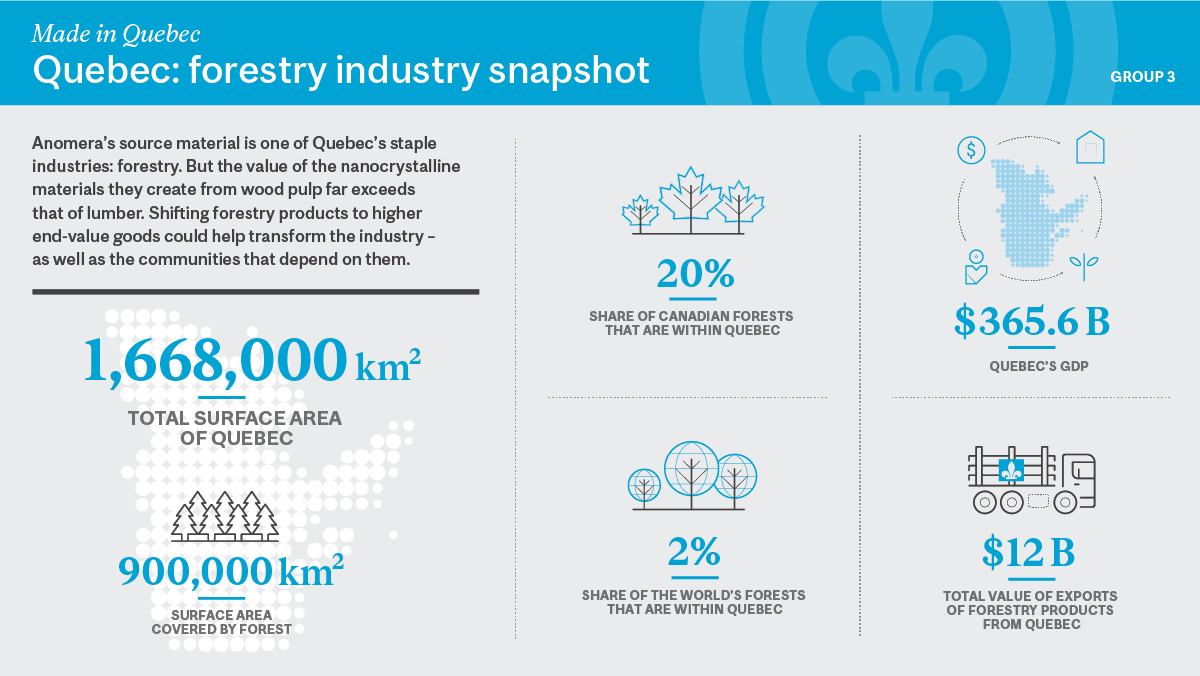
All of this is great news for the Quebec forestry sector, which has been in decline for decades. Although the province accounts for 20% of all Canadian forests, the number of jobs the industry supports has been shrinking; the workforce in Quebec’s forestry and logging sector has shrunk by more than 60% since 1998, and today employs roughly 60,000.
The fact that Anomera’s SMF in Témiscaming will eventually employ 30 people is big news in a town where forestry is more than just a source of employment – it was the reason the town existed in the first place. Anomera however will need a plant far larger than the SMF as they expand into new markets. Annual production volumes could reach into the tens of thousands of tonnes, and require hundreds of workers.
Looking ahead, the key to Anomera’s growth isn’t tied up in one industry, but in the wide variety of applications their technology has. While cosmetics is a lucrative market worth over $530 billion US in 2018, it is only one dimension of their product mix. The CNCs that Anomera can produce are a true platform technology, and through developing applications in advanced manufacturing in a multitude of industries Anomera is on track to be a major player supplying materials which can enhance many products while offsetting environmental impacts.
Fields outlines the potential of CNCs in the cement industry: “By adding only 0.03% of our CNC called DextraCel to various cementitious materials, including poured concrete, the end product has enhanced compressive strength of 15-25% and greater flexural strength. This is a most remarkable improvement.” Concrete, by the way, is the second-most used material in the world next to water – 10 billion tons of it used every year. The strength increase of Anomera’s formulation could help the industries build better, cut costs, and reduce the enormous carbon footprint of cement – estimated to contribute 8% of the world’s total greenhouse gases.
But wait, as the saying goes, there is more. Anomera’s CNCs have potential uses in adhesives, paints, and in pharmaceutical products, all of which are enormous industries unto themselves. Collectively, they represent perhaps trillions of dollars of activity – and suggest that for the submicroscopic particles produced by Anomera, the sky is indeed the limit. Good thing they already have the rocket in place.
